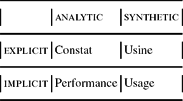Refine search
Actions for selected content:
48202 results in Computer Science
1 - Introduction
-
- Book:
- Inequalities for Graph Eigenvalues
- Published online:
- 05 August 2015
- Print publication:
- 23 July 2015, pp 1-27
-
- Chapter
- Export citation
NLP meets the cloud
-
- Journal:
- Natural Language Engineering / Volume 21 / Issue 4 / August 2015
- Published online by Cambridge University Press:
- 22 July 2015, pp. 653-659
-
- Article
-
- You have access
- Open access
- HTML
- Export citation
Revisiting the ontologising of semantic relation arguments in wordnet synsets
-
- Journal:
- Natural Language Engineering / Volume 22 / Issue 6 / November 2016
- Published online by Cambridge University Press:
- 22 July 2015, pp. 819-848
-
- Article
- Export citation
NLE volume 21 issue 4 Cover and Back matter
-
- Journal:
- Natural Language Engineering / Volume 21 / Issue 4 / August 2015
- Published online by Cambridge University Press:
- 22 July 2015, pp. b1-b6
-
- Article
-
- You have access
- Export citation
NLE volume 21 issue 4 Cover and Front matter
-
- Journal:
- Natural Language Engineering / Volume 21 / Issue 4 / August 2015
- Published online by Cambridge University Press:
- 22 July 2015, pp. f1-f2
-
- Article
-
- You have access
- Export citation
Transcendental syntax I: deterministic case
-
- Journal:
- Mathematical Structures in Computer Science / Volume 27 / Issue 5 / June 2017
- Published online by Cambridge University Press:
- 20 July 2015, pp. 827-849
-
- Article
- Export citation
Computing with lambda-terms: A special issue dedicated to Corrado Böhm for his 90th birthday
-
- Journal:
- Mathematical Structures in Computer Science / Volume 27 / Issue 5 / June 2017
- Published online by Cambridge University Press:
- 20 July 2015, pp. 557-559
-
- Article
-
- You have access
- Export citation
INDEX
-
- Book:
- A Guide to NIP Theories
- Published online:
- 05 July 2015
- Print publication:
- 16 July 2015, pp 155-156
-
- Chapter
- Export citation
APPENDIX A - EXAMPLES OF NIP STRUCTURES
-
- Book:
- A Guide to NIP Theories
- Published online:
- 05 July 2015
- Print publication:
- 16 July 2015, pp 133-144
-
- Chapter
- Export citation
APPENDIX B - PROBABILITY THEORY
-
- Book:
- A Guide to NIP Theories
- Published online:
- 05 July 2015
- Print publication:
- 16 July 2015, pp 145-146
-
- Chapter
- Export citation
CHAPTER 2 - THE NIP PROPERTY AND INVARIANT TYPES
-
- Book:
- A Guide to NIP Theories
- Published online:
- 05 July 2015
- Print publication:
- 16 July 2015, pp 7-30
-
- Chapter
- Export citation
REFERENCES
-
- Book:
- A Guide to NIP Theories
- Published online:
- 05 July 2015
- Print publication:
- 16 July 2015, pp 147-154
-
- Chapter
- Export citation
CHAPTER 5 - FORKING
-
- Book:
- A Guide to NIP Theories
- Published online:
- 05 July 2015
- Print publication:
- 16 July 2015, pp 57-72
-
- Chapter
- Export citation
CHAPTER 7 - MEASURES
-
- Book:
- A Guide to NIP Theories
- Published online:
- 05 July 2015
- Print publication:
- 16 July 2015, pp 85-100
-
- Chapter
- Export citation
CHAPTER 9 - DISTALITY
-
- Book:
- A Guide to NIP Theories
- Published online:
- 05 July 2015
- Print publication:
- 16 July 2015, pp 121-132
-
- Chapter
- Export citation
SOME NEW RESULTS ON THE LARGEST ORDER STATISTICS FROM MULTIPLE-OUTLIER GAMMA MODELS
-
- Journal:
- Probability in the Engineering and Informational Sciences / Volume 29 / Issue 4 / October 2015
- Published online by Cambridge University Press:
- 16 July 2015, pp. 597-621
-
- Article
- Export citation
CHAPTER 8 - DEFINABLY AMENABLE GROUPS
-
- Book:
- A Guide to NIP Theories
- Published online:
- 05 July 2015
- Print publication:
- 16 July 2015, pp 101-120
-
- Chapter
- Export citation

